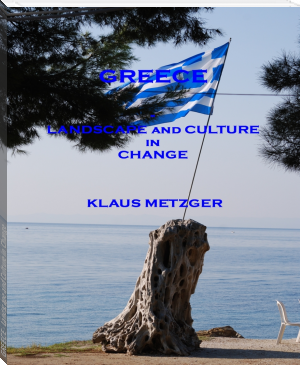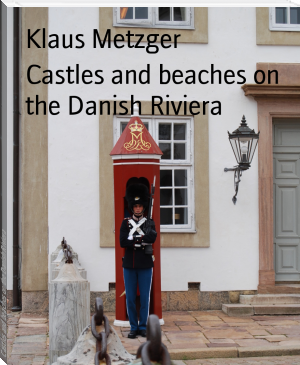GREECE - Landscape and Culture in Change by Klaus Metzger (thriller book recommendations TXT) 📕

- Author: Klaus Metzger
Book online «GREECE - Landscape and Culture in Change by Klaus Metzger (thriller book recommendations TXT) 📕». Author Klaus Metzger
The small port of Porto Cheli was almost meaningless for us. Once we walked with Dimitri evening on the promenade. Dimitri met a Greek friend who spoke contemptuously of his short shorts. Obviously, there is also in this dusty part of Greece a strict dress code.
But there was - in addition to the extensive water sports in the private cove - special attractions for which it is worthwhile to travel to the Peloponnese. With Dimitri, Giotta, his two sons Mello and Anastasian we had become friends despite language barriers. Therefore, Dimitri operated on Thursday, August 7, 1986, as a knowledgeable guide. We packed his and my family in my AUDI 100 (according to German Road Traffic Regulations two people too much) and drove to the first ancient highlight: the famous amphitheater of EPIDAUROS with the ancient Asclepius Clinic.
Admission to the museum "EPIDAUROS"
Epidauros is the most important ancient place of worship for the god of healing, Asclepius in Greece. It is located on the territory of the present town of Lygourio (district Asklipio, community Epidavros) in the Peloponnese in the region Argolis about 30 km from the town of Nafplio and about 13 km from Palea Epidavros (the small port town for the arrival and departure of the person seeking healing) away. Since 1988 it is a UNESCO World Heritage Site.
Holiday 1986, the Peloponnese / Greece
The most impressive and still most prominent building of Epidauros is undoubtedly the large, built into a hillside theater with spectacular views of the mountains of Argolis. It dates from the 4th century BC. AD. (~ 330 v. Chr.), from late classical period and is according to Pausanias the work of Polykleitos be. In particular, the large, semicircular auditorium which is about 170/160 BC. Up to 14,000 people can be present after conversion, also impressed visitors today. We are enthusiastic about the climbing of stairs, impressed of the unique view.
The theater has excellent acoustics, so you can understand from the top rows of each word. This is achieved presumably through the arched shape of the seat down stones. A popular "acoustic test" in the theater of Epidaurus is dropping a coin on the stone slab in the center of the stage ring that can be easily heard by the highest rank. Since 1952, regular classical dramas are again presented and draw - as it was then - spectators from all over Greece in the summer months at Epidaurus.
Unfortunately, I should not see again this phenomenal building of ancient Greece, 20 years later during our educational journey. The second stop was the famous historical Mycenae. It had already become very hot and we had under these conditions, about 50 km northwest rearing cover. Giotta that had to do with cancer, was left on the shaded parking in the car, while the rest of the team went to the Greek early history.
Mycenae was in pre-classical period one of the largest cities in Greece. According to her, the Mycenaean culture was named. The town was located north of the plain of Argos on a hill. From here on they watched and controlled the land route between southern southern Peloponnese and the Isthmus of Corinth, who then joined the Peloponnesian peninsula with the rest of the mainland. Since 1999, Mycenae, Tiryns and forms part of a UNESCO World Heritage Site.
Holiday 1986, the Peloponnese / Greece
Receive and excavated include today the ruins of the Mycenaean Upper Town. Noteworthy are the remains of the Cyclopean city walls and the Lion Gate. It was named after the two lions, which are shown on a relief above the gate input, and formed the main entrance to the castle. Presumably, the gate was built in 1250 BC. A second smaller, but not entirely preserved gate without gemstones is located in the northern part of the ancient system.
The Lion Gate (2006)
Of great importance are two large grave circle (A and B), which were characterized by steles. In the grave circles each found a number of shaft graves with very rich grave goods such as terracotta, pottery, gold masks, jewelry made of gold foil, etc. In five shaft graves were 17 bones (mostly men) to find. Grave circle A, which has already been discovered by Heinrich Schliemann came in later extensions of the castle in the castle wall.
Holiday 1986, the Peloponnese / Greece
Grave circle B has only been excavated in the early 1950s. In it they found even older graves than in the grave circle A. They date from the late 17th or early 16th century BC. And are thus at the very beginning of the Mycenaean period. The earliest graves of grave Runds A, roughly dating from the mid-16th century. BC.
These impressions in 1986 were so overwhelming to me that it needed only a catalyst in the person of my second wife JUTTA to me with antiquity intense - but with a ten-year delay (1996 I had the "mystical" encounter with JUTTA in Hildesheim) - to address. Only now did for me trips to Rhodes (2001), to Crete (2005) and the "search for clues in Ancient Greece" (2006) sense. Also to outside Europe, we undertook educational journeys: India (2007), Kenya (2009) and China (2011).
The conclusion of our culture trip was the port city of Nafplio. We had to travel 20 km to the south. Dimitri gave instructions to take the fortress Palamidi. From there you had a wonderful view of the city, the beaches and the harbor. During the formation of Travel (2006) we were in Nafplio. I would like to JUTTA shown this view. Unfortunately, we only visited the streets near the harbor!
The city proper has 14,203 inhabitants (2011) and was from 1829 to 1834, the provisional capital of Greece. The town of Nafplio was last increased significantly by incorporations in 2011 and is home to 33,356 inhabitants.
Nafplio was a year besieged during the Greek War of Greek revolutionary troops and finally conquered in December 1822. From 1829 to 1834 Nafplio was Aegina (1827-1829) was the second capital of modern Greece after independence from the Ottoman Empire. 1833, the city became the residence of Otto of Bavaria, who was a Greek king. In 1834, the Court moved to Athens, which has since the Greek capital.
Holiday 1986, the Peloponnese / Greece
After so much history and considerable temperatures we were looking for in a small forest below the fort a cool picnic place. The folding camping chairs we had there and our ladies were already employed prior to departure with the right diet. Also for cool drinks was taken care of.
Sunrise over the Bay (1986)
The holiday house "Mäandros" had another stimulus, because of the terrace you could watch the sunrise over the bay in the early morning. Since my travels in South America (1972) I was able to inspire sunrises and sunsets. Under the title "Impressions" I have a picture book designed (with shots around the globe).
Holiday 1986, the Peloponnese / Greece
On Monday, August 11, 1986, our beautiful and impressive holiday season had ended. The tenant Dimitri and his family we had befriended. They invited us to spend Christmas with them in Athens. Fate has it then changed his mind wanted with us, I experienced an economic crash that led to our divorce in 1989. Only JUTTA helped me in 1996 to bring back into my life right. When we went to visit our educational journey in 2006 by Greece and Athens, I had the friendly Tenant couple - to my regret - forget it.
On the way back we came apace (also because we were able to pass the difficult mountain stage of Thessalonki to Skopje at day time). Late tursday evening, August 12, 1986, we were already on the Tauern motorway. Surprisingly, I found a private lodging in Flachau. To Munich, there were only 200 km long. We arrived sweaty and dirty and were on Wednesday morning, August 13, 1986, transformed, because the shower and change of clothes worked wonders.
In Munich I gave Generalkonsul Norbert Handwerk from three 10-liter container of olive oil from its Greek property. 1.5 hours we talked about our holiday experiences and his difficulties with the tenants who supervised his plantation before Dimitri. He knew of Giotta's cancer and tried to help her. From him I learned that he has the blue Mazda pickup Dimitri given.
As we left the office of his film production company Island 12 clock, I had no idea that we had seen one last time (he died in 1991 of heart failure) - as Dimitri and his family. The onward journey is quickly told: In Söllingen near Baden-Baden we got Ulla's mother and then went on to Hildesheim. We arrived there on the evening of August 13, 1986. An exciting and dangerous adventure we had arrived safely.
2001 - go on the ramparts of RHODES
Upon your approach, on Thursday, October 4, 2001 at 8 clock, I could make a big difference to the landscape in the Peloponnese, where we had spent our 1986 Windsurfer holiday. In particular, the northern part of the island was densely built. After the later 2011 census the island had 115,490 inhabitants, of which almost half of Rhodes Town, the main town and tourist center in the north of the island.
The island of Rhodes is also known as a surfing paradise. After extensive surfing holiday in 1986 was an almost 10 years break until I ventured to the Giftener ponds in Sarstedt back on my surfboard. With our move in 1998 to Itzum (a district of Hildesheim) my surfboard forever disappeared in the basement. Therefore, we only had swimsuits in our luggage.
My friend and advisor, Prof. Dr. Dr. Heutger, belonged to the Templar Order (such as the Knights a former Crusader Medal) to (he died in 2008 Curacao). This gave me an interest in the Knights of Rhodes. The Order of St. John was built after the conquest of Jerusalem in the First Crusade in 1099. After the expulsion from the Holy Land by the muslim warriors took place from 1306, the relocation of the Order of St. John Rhodes.
1306 joined the Genoese Vigniolo de 'Vignoli, who (in the eastern Aegean island group) had different areas in the Dodecanese and wanted to build on the still formally belonging to the Byzantine Empire Rhodes own rule, a contract with the Order of St. John. For their assistance in the implementation of his political plans, he secured the Knights under its former Grand Master Fulk de Villaret to its own territory on the island.
Diplomatic hedged through the support of the Pope, the 1307 should award them an everlasting Rhodes property, the Knights began the systematic conquest of the island. Besides Byzantine troops there were also several Genoese competitors Vignolis and even a group of Turks who oppose them. Therefore, the seizure of Rhodes took several years and ended with the conquest of the Greeks, the political disempowerment of the Genoese and the Turks.
After the Byzantine commander had besieged





Comments (0)